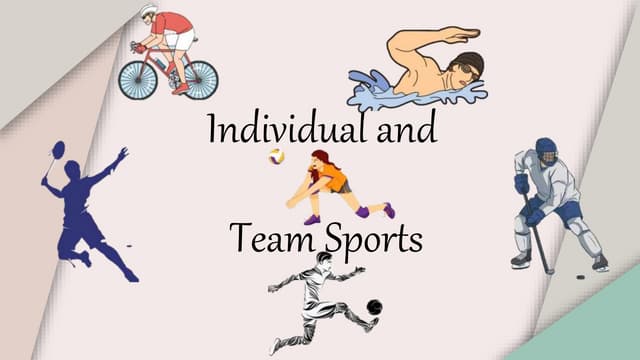Understanding Individual Sports: Definition, Characteristics, and Benefits

Understanding Individual Sports: This sports have a unique charm that sets them apart from team This. These sports require athletes to perform and succeed based on their skills, strengths, and efforts, without depending on teammates for support or performance. While team sports rely on the collective effort of players working together toward a common goal, This is are all about personal determination, self-reliance, and overcoming challenges on one’s own. In this article, we will dive deep into the definition of This is, explore the different types, understand the benefits of participating in them, and discuss why they continue to captivate athletes and fans alike.
What Are Understanding Individual Sports?
At its core, individual sports refer to any sport where participants compete alone rather than as part of a team. These sports typically require athletes to perform at their best to achieve a personal goal or benchmark, often in the form of time, distance, or skill-based objectives. In This is, the individual athlete is solely responsible for their performance, and the outcome of the competition is determined by their efforts alone. The emphasis is on personal discipline, focus, and resilience.
Unlike team sports, where strategy, coordination, and teamwork are crucial elements, This is place the spotlight on the This talent, determination, and mental toughness. Whether it is running a marathon, swimming a race, or competing in a solo event like gymnastics or tennis, these sports require a different mindset from athletes.
Types of Individual Sports
There are many different kinds of individual sports, each offering unique challenges and opportunities for athletes. Some sports are entirely focused on the individual’s performance in a controlled environment, while others involve direct competition with other athletes.
- Track and Field Sports: These include running, hurdles, long jump, pole vault, and shot put. In these sports, athletes compete against each other or a set standard (like a world record). The primary focus is on physical endurance, speed, and strength.
- Racquet Sports: Tennis, badminton, and squash are examples of individual sports that involve a racquet. In these sports, players face off one-on-one against an opponent and must rely on skillful maneuvering, quick reflexes, and mental fortitude.
- Water Sports: Swimming, diving, and water polo are considered individual sports, although water polo can also be played in teams. Swimming events, for example, are often individual races, where swimmers compete for the best time.
- Combat Sports: Boxing, martial arts, and wrestling are all individual sports that require physical strength, discipline, and technique. These sports focus on hand-to-hand combat and testing the skill of the athlete.
- Winter Sports: Skiing, snowboarding, and ice skating are individual sports that take place in cold weather conditions. Athletes compete to achieve the fastest times, best stunts, or highest points based on their performance in events.
- Gymnastics and Dance: In gymnastics and dance, athletes are judged based on their physical skill, flexibility, balance, and precision. These performances are individual but require an immense amount of training and dedication to perfection.
- Endurance Sports: Sports like cycling, marathon running, and triathlons fall under the category of endurance sports. Athletes compete based on their ability to withstand physical stress for long periods.
Key Characteristics of Individual Sports
Individual sports come with their own set of unique characteristics that differentiate them from team sports. These traits influence how athletes approach training, competition, and success in their respective fields.
Self-Reliance and Independence
One of the most prominent characteristics of individual sports is the level of independence required from the athlete. Success or failure in these sports largely depends on the individual’s effort. The athlete is solely responsible for their training, mental focus, and performance. Unlike team sports, where the outcome depends on teamwork and collective strategy, individual sports force athletes to look inward for motivation and self-discipline.
This independence also extends beyond just physical performance. The athlete must make their own decisions on how to approach competition, what strategies to use, and how to stay mentally sharp during events. The mental aspect of individual sports is just as important as the physical. An athlete must learn to cope with pressure, manage expectations, and remain calm in the face of adversity.
Personal Accountability
In individual sports, accountability falls squarely on the shoulders of the athlete. Unlike team sports, where blame can often be shifted or shared among teammates, an individual athlete cannot hide behind a team effort. Whether they win or lose, it’s their performance that counts. This can be both empowering and challenging. The sense of personal responsibility is one of the reasons many athletes are drawn to individual sports in the first place. They are motivated by the desire to improve themselves, set personal records, and see how far their hard work can take them.
However, this high level of accountability can also be a source of stress. Athletes in individual sports may experience greater pressure, knowing that their performance directly influences the outcome of the competition.
Mental Toughness
Mental toughness is crucial in individual sports. Since there is no team to rely on, athletes must develop the mental resilience to face challenges head-on. Whether it’s the grueling hours spent in training, the physical exhaustion during a race, or the intense pressure of competition, mental strength is often what separates good athletes from great ones. The ability to push through pain, doubt, and fatigue is essential for success in individual sports.
Many individual athletes train their minds just as much as they train their bodies. Visualization techniques, mindfulness, and relaxation exercises are common practices that athletes use to calm their nerves and improve their focus. By preparing mentally, athletes increase their chances of performing well when it matters most.
The Benefits of Individual Sports
While every sport offers its own set of benefits, individual sports come with a host of advantages that are particularly unique to athletes who compete alone. These benefits not only help athletes grow in their sport but also have a lasting impact on their personal development and well-being.
Improved Focus and Discipline
In individual sports, success is determined by how well an athlete can focus on their goals and stay disciplined during their training. Since they don’t have teammates to keep them accountable, athletes in individual sports must cultivate self-discipline in every aspect of their lives. They are responsible for their schedule, diet, recovery, and overall performance. This level of discipline builds strong work ethics that often translate into other areas of life, including school, work, and personal relationships.
The training for individual sports requires consistency, and athletes must regularly push themselves to improve. This consistent practice helps them build a high level of focus and commitment.
Personal Growth and Self-Esteem
Competing in individual sports can have a profound impact on an athlete’s self-esteem and sense of personal growth. Achieving personal goals—whether it’s shaving seconds off a race time, lifting heavier weights, or perfecting a specific skill—can foster a deep sense of accomplishment. This feeling of success is often more personal and rewarding in individual sports because it is the result of the athlete’s effort and perseverance.
As athletes in individual sports face challenges, overcome obstacles, and continually strive for better performance, they learn important lessons in resilience, patience, and perseverance. These qualities are invaluable in life, helping individuals navigate both personal and professional challenges.
Enhanced Time Management Skills
Because individual athletes are responsible for all aspects of their training and competition, they develop strong time management skills. Balancing training with other responsibilities, such as school or work, can be demanding, but it forces athletes to prioritize their time and make the most of every moment. Learning how to efficiently manage time in This can have a positive effect on all areas of an athlete’s life.
Building Mental Resilience
One of the most important aspects of competing in individual sports is developing mental resilience. Unlike team sports, where athletes can rely on teammates for emotional support, athletes in individual sports must rely on their mental fortitude to push through difficult situations.
The constant drive for improvement and the internal pressure to perform at a high level teach athletes how to deal with stress, failure, and setbacks. In the face of challenges, athletes learn how to stay focused on the process rather than being overwhelmed by the outcome. This mental resilience can help athletes succeed not only in their sport but also in life beyond the competition.

Popular Individual Sports Around the World
While individual sports span across many disciplines, some sports have gained global recognition and are considered staples in the world of athletic competition.
Tennis
Tennis is a perfect example of an This sport that combines skill, endurance, and strategy. Famous tournaments like Wimbledon, the U.S. Open, and the French Open are watched by millions of fans around the world. Tennis players must rely on their strength, speed, and tactical intelligence to compete at the highest levels. Although doubles tennis exists, most of the spotlight falls on singles matches, where players battle it out one-on-one.
Swimming
Swimming is another widely recognized individual sport, especially in the Olympic Games. Whether it’s freestyle, breaststroke, butterfly, or backstroke, swimmers aim to complete the distance in the fastest time possible. It is a sport that requires perfect technique, endurance, and mental toughness.
Golf
Golf, known for its calm pace and emphasis on precision, is another sport where individuals compete against each other based on their ability to control the ball and navigate the course. Despite the slower pace compared to other This is, golf players must show remarkable focus and patience as they aim to master their game.
Athletics
Athletics, or track and field, encompasses a wide variety of events that range from sprints to long-distance running and field events like the pole vault and javelin throw. This sport showcases an athlete’s physical capabilities and is deeply embedded in global sports culture. Whether competing at the Olympics or local meets, athletes strive to push their physical limits in pursuit of personal success.
Challenges of Participating in Individual Sports

While there are many benefits to individual sports, they also come with their own set of challenges. The mental and physical demands can be overwhelming at times. Athletes in This is must deal with the pressure of performing solo, as well as the potential for isolation and burnout. The lack of camaraderie that comes with team sports can be difficult for some athletes to handle.
Moreover, injury prevention becomes critical in This is. Without the support of a team, This athletes are often left to manage their physical health. This means they must be particularly vigilant about recovery, stretching, and addressing any injuries to avoid setbacks.
Conclusion
Individual sports provide a wealth of opportunities for athletes to challenge themselves and push beyond their limits. These sports emphasize self-reliance, personal responsibility, and mental toughness, all while offering athletes the chance to compete at their highest level. From tennis to swimming, and athletics to gymnastics ,This is offer diverse arenas where athletes can showcase their skills, build resilience, and achieve personal growth. Whether it’s the thrill of competition or the journey of self-improvement, This is continue to inspire and captivate people around the world.






